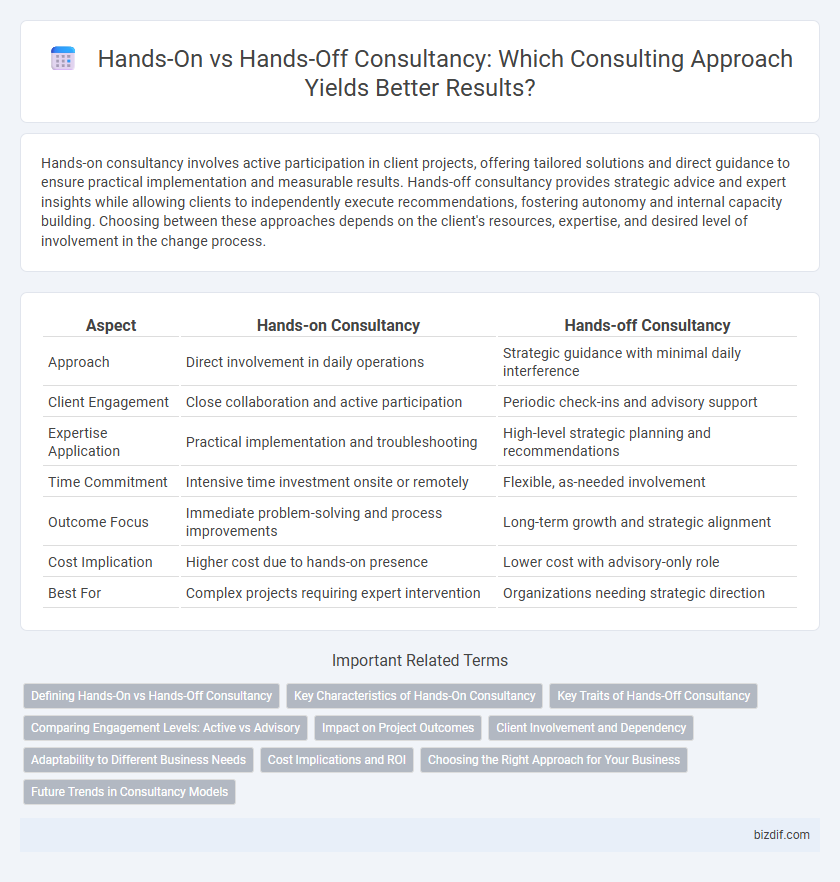Hands-on consultancy involves active participation in client projects, offering tailored solutions and direct guidance to ensure practical implementation and measurable results. Hands-off consultancy provides strategic advice and expert insights while allowing clients to independently execute recommendations, fostering autonomy and internal capacity building. Choosing between these approaches depends on the client's resources, expertise, and desired level of involvement in the change process.
Table of Comparison
| Aspect | Hands-on Consultancy | Hands-off Consultancy |
|---|---|---|
| Approach | Direct involvement in daily operations | Strategic guidance with minimal daily interference |
| Client Engagement | Close collaboration and active participation | Periodic check-ins and advisory support |
| Expertise Application | Practical implementation and troubleshooting | High-level strategic planning and recommendations |
| Time Commitment | Intensive time investment onsite or remotely | Flexible, as-needed involvement |
| Outcome Focus | Immediate problem-solving and process improvements | Long-term growth and strategic alignment |
| Cost Implication | Higher cost due to hands-on presence | Lower cost with advisory-only role |
| Best For | Complex projects requiring expert intervention | Organizations needing strategic direction |
Defining Hands-On vs Hands-Off Consultancy
Hands-on consultancy involves active engagement where consultants directly participate in implementing strategies and guiding daily operations, ensuring tailored solutions and immediate feedback. Hands-off consultancy, by contrast, centers on providing expert advice and strategic recommendations while leaving execution primarily to the client, promoting autonomy and long-term capability building. Defining these approaches clarifies roles, expectations, and the level of involvement consultants maintain throughout the project lifecycle.
Key Characteristics of Hands-On Consultancy
Hands-on consultancy involves active engagement and direct collaboration with clients to implement solutions, ensuring real-time problem-solving and customized strategies. Key characteristics include in-depth involvement in daily operations, continuous feedback loops, and practical guidance that drives immediate impact. This approach fosters strong client partnerships through transparency, adaptability, and measurable outcomes.
Key Traits of Hands-Off Consultancy
Hands-off consultancy emphasizes strategic guidance without direct involvement in daily operations, fostering client autonomy and long-term capability building. It relies on clear communication, trust in the client's expertise, and delivering actionable insights rather than micromanaging processes. This approach prioritizes empowering organizations to implement solutions independently while consultants provide expert advice and oversight.
Comparing Engagement Levels: Active vs Advisory
Hands-on consultancy involves active engagement where consultants work directly with clients to implement solutions and drive change, ensuring real-time problem-solving and adaptation. Hands-off consultancy provides advisory support through strategic recommendations, empowering clients to take ownership while maintaining guidance from a distance. Comparing engagement levels highlights that hands-on consultancy offers immersive collaboration, whereas hands-off consultancy prioritizes expert advice with minimal direct intervention.
Impact on Project Outcomes
Hands-on consultancy directly involves consultants in the day-to-day project activities, leading to enhanced problem-solving efficiency, real-time decision-making, and improved alignment with client objectives. In contrast, hands-off consultancy provides strategic guidance with minimal direct intervention, which may limit immediate impact but fosters client autonomy and long-term capability building. Project outcomes tend to show higher short-term success rates with hands-on approaches due to active consultant engagement and continuous support.
Client Involvement and Dependency
Hands-on consultancy requires active client involvement, fostering collaboration and immediate feedback to tailor solutions precisely to organizational needs. Hands-off consultancy minimizes client dependency by delivering strategic guidance and frameworks that empower clients to implement changes independently. Balancing these approaches depends on the client's capacity for engagement and desire for autonomy in decision-making processes.
Adaptability to Different Business Needs
Hands-on consultancy offers tailored, immersive support that adapts closely to specific operational challenges, providing direct involvement in executing solutions. In contrast, hands-off consultancy emphasizes strategic guidance, allowing businesses to maintain autonomy while receiving expert advice suited to their unique context. Both approaches prioritize flexibility, with hands-on being ideal for businesses needing detailed assistance and hands-off suiting those seeking independent implementation.
Cost Implications and ROI
Hands-on consultancy involves direct engagement with a company's processes, often leading to higher upfront costs due to intensive time and resource commitment but potentially yielding quicker, measurable ROI through immediate problem-solving. Hands-off consultancy typically requires lower initial investment by providing strategic guidance and recommendations without deep operational involvement, which may result in delayed or less tangible ROI. Evaluating cost implications and projected ROI depends on business needs, project complexity, and the desired speed of implementation.
Choosing the Right Approach for Your Business
Hands-on consultancy involves direct engagement with your team, offering practical guidance and implementing solutions to address specific business challenges effectively. Hands-off consultancy provides strategic insights and recommendations, empowering your leadership to make informed decisions independently while maintaining operational control. Selecting the right approach depends on your organization's needs, resource availability, and desired level of external involvement to optimize business performance and growth.
Future Trends in Consultancy Models
Hands-on consultancy emphasizes immersive client collaboration and customized implementation, leveraging emerging technologies like AI and data analytics to drive decision-making accuracy. Hands-off consultancy prioritizes strategic advice and knowledge transfer, promoting client autonomy while integrating digital platforms for remote support and scalable solutions. Future trends indicate a hybrid approach combining personalized engagement with technology-enabled scalability to optimize value delivery across diverse industries.
Hands-on consultancy vs Hands-off consultancy Infographic

 bizdif.com
bizdif.com